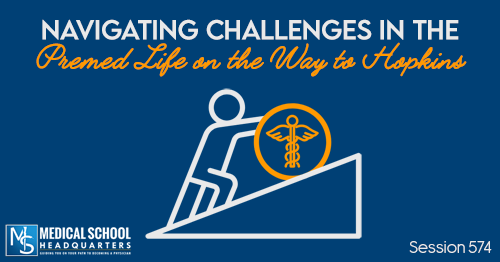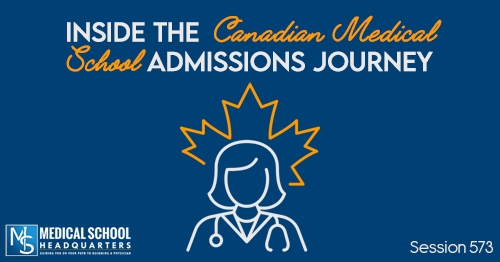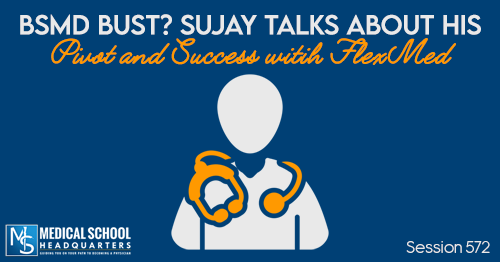Apple Podcasts | Google Podcasts
Session 475
Today, we talk to Dr. Bryan Carmody about some obstacles osteopathic medical schools may face in the future with student loan changes as well as some other interesting topics.
Bryan actually put out on YouTube a presentation that he gave to a group of osteopathic medical school deans. In his presentation called Addressing Osteopathic Medicine’s Vulnerabilities: The View through an External Lens, Bryan gives an external perspective on the vulnerabilities of osteopathic medical education.
Today, Bryan shares his thought process behind his presentation and how you as a premed student can make the best decision possible as it relates to your future career. For more podcast resources to help you with your medical school journey and beyond, check out Meded Media.
Listen to this podcast episode with the player above, or keep reading for the highlights and takeaway points.
[02:52] Interest in Becoming a Physician
Bryan’s decision to get into medical school was a gradual thing. He thinks it started early, but he wasn’t sure about it up until he really applied to medical school and got accepted.
Bryan is a practicing pediatric nephrologist and he runs a very active Twitter account.
[05:01] Balancing Life as Early as Premed
'You should start early practicing the skill of balancing your life with your work.'Click To TweetBryan wishes to tell students that it is just not realistic to think that the external world is going to make them have more time for things they want to prioritize. As you move on, life will stay busy and you have to come to terms with working hard on whatever your hands are on and then doing something else. And you have to be fully present and engaged in whatever that other thing is. It’s a skill that you need to recite and practice, and it starts when you’re a premed.
He adds that it’s easy to get into the mindset of “having to get through this and then real life begins.” But if you keep that attitude, then real life never begins.
Humans fall into a trap of always reaching for that finish line and only see success as getting the MD or DO. There are these life experiences along the way that they miss out on and then they get burnt out and they’re miserable. When instead, they fail to wake up every day and celebrate the little successes that continue to motivate them and keep them going.
[07:14] The Story Behind His Talk
Bryan prefaces that he is not a DO. He is an MD but he is an observer of medical education. The reason he was asked to give a presentation to the osteopathic medical school deans is to be able to provide a different perspective versus the perspective they often hear in their internal discussions.
At the hospital where he works, they work with a fair number of Osteopathic students who choose to do electives during their fourth year at the hospital. They also have a residency program where 40% of their residents in recent years have come from osteopathic medical schools. That being said, he thinks osteopathic medical students and residents with a DO degree do very well for themselves.
In the video, Bryan’s insight is mostly around the cost of osteopathic medical schools. Anecdotally, osteopathic medical schools are typically more expensive than their MD counterparts.
Bryan’s interest in looking at cost of attendance for osteopathic medical schools was based on what his audience asked him to do, which was to help them with their strategic planning.
[11:20] The Dangers of Rapid Expansion
Recently, there’s been a large expansion in a number of DO medical schools. Bryan explains this is not necessarily a bad thing, especially if you believe in osteopathic medicine.
However, there are some repercussions to rapid expansion, especially that the outcomes in the match and the residency match for osteopathic students are not quite as good as they are for those with the MD degree. And so, it’s not going to be a good combination if you’re offering a product that doesn’t give you quite the same professionalism options and it costs more.
'If you expand rapidly, the quality of the students that you take in declines, at the same time, the market for resident physicians continues to tighten.'Click To TweetThat being said, graduate medical education is now under a single system run by the ACGME. And so, it’s hard to make good comparisons of match outcomes with the single accreditation now that we have one set of numbers to look at.
And Bryan adds that it’s may take a while for things to settle out because a lot of things are changing. Single accreditation is certainly one. There’s also the number of students entering the match from MD and DO schools and the schools they come from. When you have newer schools, you have institutional experience in getting your students placed in the match and so on.
So there are other variables at play here. But it’s going to be very interesting how things shake out over the next several years.
[15:20] The Impact of Institutional Experience on the Match
When you’re looking at an applicant at a glance, there are certain fundamental differences between the ways that applications are reviewed for graduate medical education and for undergraduate medical admissions. And Bryan believes that name recognition matters.
Several medical schools, both MD and DO, have expanded and set up in more rural areas. There are real benefits to that.
But there’s a real challenge, too, which is getting your students the clinical experience they need. Often, that requires farming students out to various hospitals in your third and fourth year. And if you have to do that, it helps to have some relationships established with hospitals. It will give your students meaningful opportunities and give them the chance to advance when they apply for residency.
If you’re in a mature school that has been doing all that stuff for a while, you probably have relationships with people for away rotations and you probably have your system down. But if you’re a newer school, sometimes you’ve got to work through that stuff a little bit.
“Osteopathic schools, for the most part, don't have relationships, and aren't in proximity location-wise, to big academic medical centers.”Click To TweetOsteopathic schools typically aren’t associated with those big medical centers. And so either the school is doing the work to find placements, or the student sometimes has to do the work to find those placements. And so, potentially, from a networking standpoint, you just aren’t exposed to the people and making those invitation-type decisions to just network and build your network as a medical student.
[18:55] Not Enough Exposure to a Variety of Patients
To become a good physician, you need exposure to a wide variety of patients. Students, unless they go get some fantastic away rotations, are probably not going to get exposure to a wide swath of medicine. And this is one of Bryan’s concerns. This is another vulnerability that needs to be addressed for osteopathic medicine in general.
For a typical or traditional MD school, where every specialty is housed in the same big giant university medical center, it’s easier for their students to get that experience in one place. Whereas, DO schools still have to cultivate that relationship or pay for that privilege to have your students rotate in far-flung hospitals.
They’re not all part of the same system and so it can be strange trying to make all of that work.
[20:29] The Impact of Loan Forgiveness
There’s a greater proportion of osteopathic medical schools that are private versus public. But even accounting for that, osteopathic medical education is going to cost you a little bit more, you know in general than an MD education would.
And so, it’s a big deal. Coming out of medical school with a bit of debt can impact your life. And if you have a plan to do a loan repayment program, that can be life-changing, if you’re saddled with a lot of debt.
'Osteopathic medical education is going to cost you a little bit more in general than an MD education would.'Click To TweetAlternatively, you could have a political system in the future where there is less willingness to entertain these kinds of loan forgiveness. Bryan says this is a political thing that osteopathic leaders should be working actively on to strengthen their schools.
They need to lobby more to encourage other forms of loan forgiveness. For instance, if you have graduates who come back to that area and fulfill the school’s mission, you should push the politicians to reward the students who do that.
[23:09] Budgets of Medical Schools
Also in his presentation, Bryan laid out that the large percentage of revenue for osteopathic schools comes from tuition. Whereas for allopathic medical schools, the tuition was a lot smaller percentage of their overall revenue.
Bryan explains that most MD granting schools are attached to a giant academic medical center, which is a ginormous financial enterprise that brings in tons of revenue. The medical school is often administratively housed alongside the revenue that comes in from patient care at the hospital. This means tuition revenue comprises a very small portion of an average MD school’s revenue. There’s a giant pot of money that could be allocated to cover that if people wanted it to.
In contrast, osteopathic medical schools are generally just schools. There’s not a whole lot of revenue coming in from state and local governments. There’s not a whole lot of revenue coming in from patient care unless there’s an affiliated academic medical center. There’s not a lot of research activity that draws in NIH-funded grants.
DO schools have this complex financial enterprise that’s really dependent on a single revenue stream, and that is tuition. This is another vulnerability that Bryan has highlighted.
And in the future, that changes students’ willingness to pay higher and higher tuition, or your ability to get loans for your students to allow you to keep doing higher and higher tuition. Any of those things are going to render your institution very vulnerable to whatever stress may occur in the future.
Ultimately, if tuition is a small portion of your sort of institutional lifeblood, it’s not that big of a deal if you couldn’t increase tuition. Because you have so much revenue coming in from research grants, faculty medical practice, etc. That’s not the case for DO schools, however, because once the tuition revenue is taken out, it could put them under serious financial stress.
[31:43] Thoughts on Income-Sharing Agreements
Income-sharing agreements are popular in the tech industry. Where instead of going to a traditional four-year college, you could go to a coding school. They’re going to teach you how to code so you can get a job at Google. And they’re not going to charge you. But you’re going to give them a percentage of your salary up to a certain percentage in the future.
There are now undergraduate institutions that are jumping on board with income-sharing agreements.
Imagine the student goes to college, gets their degree, and technically comes out with no loans. But they have a contract that says a percentage of their salary that they’re going to make moving forward is going to go back to their undergraduate institution. It gives people more flexibility in the choices of jobs they have to get because they don’t have this huge number of student debt looming over their heads.
Personally, I think medical school is just the perfect opportunity for this where more and more people are going into specialties that they want to go into. And it’s not because they think they need to go to so they can pay off their loans.
Bryan is a bit skeptical of things like this because of the default position that such a deal would not be offered unless the person offering it felt like they were going to come out ahead. Your freedom and the jobs that you take and how you work those jobs are a real asset. Ultimately, it depends on how certain you are about your career path and what the alternative would be. But his initial bias is to be against it.
[35:30] The Impact of Step 1 Going Pass/Fail
Bryan says that not everyone is going to get that opportunity when you apply in those highly competitive fields. Many applicants are deterred from even applying in those specialties because they don’t believe they’ll be successful.
Among the ones who have enough confidence to apply still, maybe three-fourths of people successfully match. And in those highly competitive fields, MD applicants are preferred and this is backed by numbers. That being said, you’re going to have to walk a very narrow path, and exactly what that path will look like is a little bit more fraught than it used to be.
Five years ago, you need to score extremely highly on Step 1 and strong away rotations and so on. And with Step 1 scores going pass/fail, that makes it a little bit more uncertain for how some applicants will choose to distinguish themselves.
'With Step 1 scores going pass-fail, it makes it a little bit more uncertain for how some applicants will choose to distinguish themselves.'Click To TweetAll that considered, Step 2 will become the most common screening metric. And it is a big contributor to burnout in medicine.
[39:41] Avoiding Burnout
Bryan points out that you have to know in your life and in your career when enough is enough. Because whatever you do, there will always be someone in town who’s busier than you or is making more money. Whatever it is, there’s always going to be somebody who has more of it.
“If you're always measuring yourself relative to others, it's very easy to just get on this neverending ladder and just keep reaching higher and higher for these rungs that maybe don't even matter to you.”Click To TweetYou always want to be the best you can be. But being the best can’t necessarily mean giving every single ounce of everything that you have. You’ve got to come to terms with that at some point in your medical career, otherwise, you’ll suffer.
[41:53] Thoughts on Residency Matches and Medicare
More medical schools mean more graduates. And the number of residency spots is typically tied to funding that is done through Medicare that hasn’t changed much.
Bryan stresses that the purpose of medical education is to train a workforce to care for the people in our country. However, we have these different steps of that process that all function independently.
Instead, individual schools make the decision about whether they should expand or not, and they do so based on hyper-local variables. None of that has anything to do with whether they need that many more physicians – and residency positions are the same way.
And so, what goes into that decision similarly has little to do with whether you need more people in that specialty nationwide, or even in your area. It has to do with whether expanding the residency program would bring in financial incentives that exceed what it would take to hire and cover the wages and benefits of a new resident.
'The overall behavior of a system is the sum total of all these individual hyper-local decisions.'Click To Tweet[46:22] Thoughts on International Medical Graduates and The Future Primary Care Physicians
Whether he sees a future where the government or someone steps in and says you have to match every U.S. student before you will look at an international medical graduate, Bryan doesn’t think this is realistic. For one, it poses some legal challenges.
ACGME intended to shift the demographics of the physician workforce in a way that would be legally permissible. So he doesn’t think this is possible. Secondly, these big giant academic medical centers also have enormous research enterprises. And scientists who work on a work visa are in high demand to keep those labs running and the output that comes from them.
When asked about whether he sees a world where if you take federal financial aid, they are required to do two years of primary care before they match into a sub-specialty, Bryan says this is not realistic as well.
The most difficult solution to fixing the supply of primary care physicians is simply to pay them better. Unfortunately, we’re just not in a healthcare environment where any payer wants to pay any physician anymore. To pay primary care physicians more would require paying someone else less. And no one is eager to be that person to do that. So it makes it a challenging political issue.
[51:39] Message to His Premed Self
Stay curious. When something piques your curiosity, don’t be afraid to pique it out a little bit. Understanding is unlocked, or you’ll get greater joy by following your curiosity.
The same thing when you’re on the wards. When a finding doesn’t make sense, or you hear something and it just makes you wonder, give yourself a little bit of time every day.
Indulge in that curiosity because it takes you off to good places that leave you better off or more enriched. It will take you down roads you didn’t even know existed.
[53:21] The MCAT Minute
The MCAT Minute is brought to you by Blueprint MCAT.
If you are taking the test soon, don’t forget to check out the Blueprint MCAT and Sketchy partnership where you can get access to Blueprint’s amazing full-length exams, and Skethcy’s great new MCAT platform to help you learn, memorize, and retain all of the information to help you get the score you need on your MCAT.
Links:
Know more about Dr. Bryan Carmody on:
Website: The Sheriff of Sodium
Twitter: @jbcarmody
YouTube Video: Addressing Osteopathic Medicine’s Vulnerabilities: The View through an External Lens












